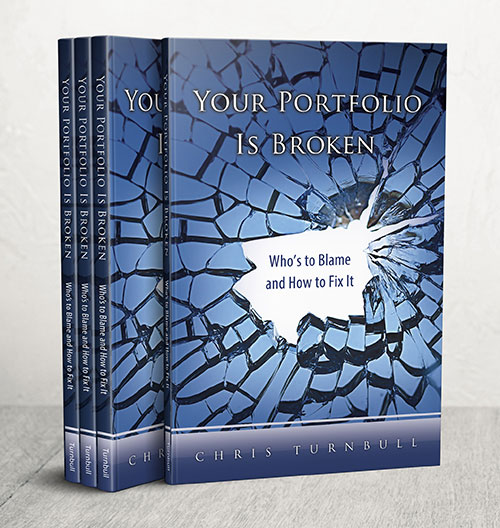
This book is intended to help frustrated investors identify problems with traditional approaches to investing and to offer a simple + modern solution.
The investment industry sells products and predictions. Investment professionals present themselves as faster and smarter investors whose acumen will generate market-beating results for investors.
Your Portfolio Is Broken: Who’s to Blame and How to Fix It debunks the claims of the investment industry. In fact, beating the market is rare, and an emphasis on good consumer and investor practices – controlling what you can control – is more effective in addressing the issues causing poor portfolio performance versus more products or more predictions.
“Is there difference between a diversified portfolio and a collection of investments? That’s an insightful question Chris Turnbull asks in his new book Your Portfolio is Broken: Who’s to Blame and How to Fix It.”
D. Bortolotti,
The Canadian Couch Potato,
Your Complete Guide to Index Investing
Read it on canadiancouchpotato.com
Chris Turnbull is a portfolio manager with over 30 years of experience working with high net worth investors. Chris holds a BA in Economics from the University of Alberta, as well as, the Chartered Financial Analyst (CFA), Certified Financial Planner (CFP) and Trust and Estate Practitioner (TEP) designations.
He has written and presented papers such as, Trustee Investment Powers, and the Higher Standards of Prudence to influential groups such as, the Certified General Accountants, the Institute of Corporate Directors (ICD), the Society for Trust and Estate Practitioners (STEP) and the Canadian Bar, Will and Estates Chapter.
Chris published his first book, Your Portfolio Is Broken: Who’s to Blame and How to Fix It in 2013.

If you’re an investor, chances are you feel frustrated… maybe a little afraid. Global stock markets have been through two 50 percent drops in the recent past. Meanwhile, the world continually teeters on the edge of our worst fears, with each new calamity threatening to topple it for good. Perhaps you’ve begun to ask, “Is investing safe?” When the richest nation in the world struggles to pay its bills, totalitarian government regimes are overthrown in mere weeks, and a major earthquake-tsunami-nuclear disaster piles onto an already alarming list of dangers, you might answer, “No! The world is simply too volatile. Where did I put that empty coffee can and rusty shovel?”
Maybe you feel the investment industry has let you down. How many “attractive” mutual funds, “promising” stock recommendations, and “good ideas” have you sampled from bankers, brokers, and TV big-talkers? After all of your effort and all of the recommendations from all of the people who are supposed to know . . . what did you really get, besides frustrated?
Or maybe you question whether investing is the same anymore. Sure, most major stock markets around the world have averaged annual returns in excess of 9 percent over many decades, but does that mean they will again? They certainly haven’t recently.
Over the last 20 years, first as an investment advisor working at a major Canadian brokerage firm and then as a portfolio manager at a private counsel, I’ve witnessed investor frustration. It’s the result of unpredictable investment markets and poor portfolio practices. Ask yourself, “Why do I invest this way?”
As an investment professional, my passion is fixing broken portfolios through a simpler, modern, and effective approach. Better investment returns require you to think differently and invest differently, and that begins by choosing an achievable strategy.
If buying another good idea from your advisor, no longer seems like the solution, this book contains information that might interest you. If you are willing to return to a non-predictive, commonsense approach to investing—controlling what you can control, eliminating unnecessary risk, understanding the sources of returns, and capturing those returns—read on!
“Most investors, both institutional and individual, will find that the best way to own common stocks is through an index fund that charges minimal fees. Those following this path are sure to beat the net results (after fees and expenses) delivered by the great majority of investment professionals.”
Warren Buffett
Berkshire Hathaway 1996 Annual Report
Paperback: $15.00
Pages: 90
ISBN: 978-0-9919881-0-5